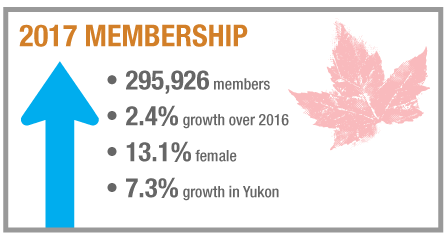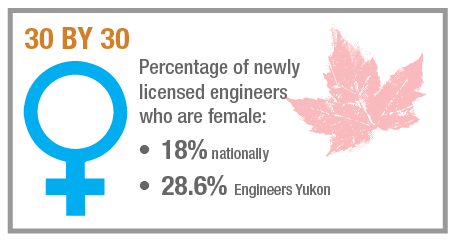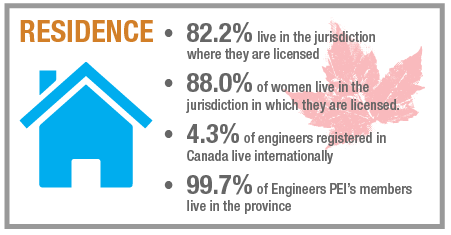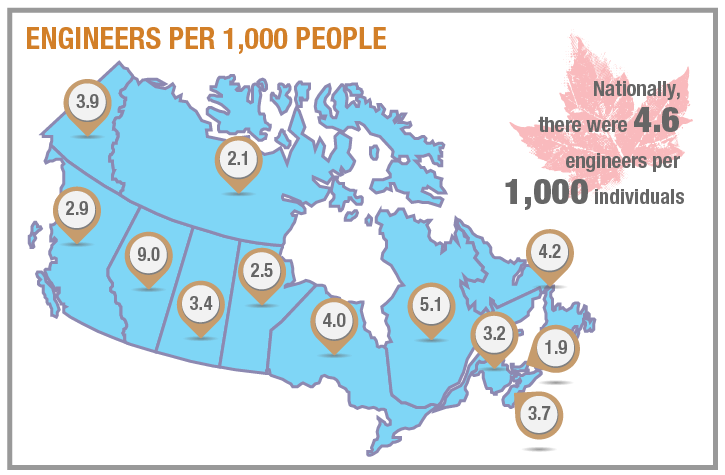NOTE 1: The original posting of this report included an error in the number of newly licensed engineers who are women. The information presented here has been updated accordingly.
The National Membership Report provides annual information on the provincial and territorial engineering regulators’ membership to deliver timely and accurate information about the engineering profession in Canada. Please find all data tables associated with this report here.
Growth in the engineering profession
 Membership in the provincial and territorial regulators grew again in 2017. In total, as of December 31, 2017, there were 295,926 members (excluding students)i of the 12 engineering regulators (see Table 1). Of these, 13.1 per cent were female, which increased from 12.8 per cent in 2016. Total membership of all regulators increased by 2.4 per cent, whereas the number of female members increased by 5.2 per cent and the amount of male members increased by 2.0 per cent.
Membership in the provincial and territorial regulators grew again in 2017. In total, as of December 31, 2017, there were 295,926 members (excluding students)i of the 12 engineering regulators (see Table 1). Of these, 13.1 per cent were female, which increased from 12.8 per cent in 2016. Total membership of all regulators increased by 2.4 per cent, whereas the number of female members increased by 5.2 per cent and the amount of male members increased by 2.0 per cent.
Since 2016, Engineers Yukon has experienced the largest percentage growth in membership (7.3 per cent). While female membership increased nationally by 5.2 per cent, Engineers Yukon experienced the greatest increase (27.3 per cent), followed by the Northwest Territories and Nunavut Association of Professional Engineers and Geoscientists (NAPEG), and Engineers Geoscientists Manitoba at 11.2 and 11.1 per cent, respectively.
There were 169,261 practising professional engineers licensed in the jurisdiction where they reside. Of these, 14.0 per cent were women (see Table 2). Excluding Association of Professional Engineers & Geoscientists of Saskatchewan (APEGS), there were 8,988 newly licensed engineers in 2017. The number of newly licensed engineers has increased nationally by 7.8 per cent since 2016.
30 by 30
 In 2015, Engineers Canada launched 30 by 30. 30 by 30, supported by all of the provincial and territorial regulators, is a commitment to increasing the number of newly licensed engineers who are women to 30 per cent by 2030. Nationally, 18.0 per cent of newly licensed engineers were women in 2017 (see Table 3). Once again, Engineers Yukon had the highest proportion of newly licensed engineers who were women at 28.6 per cent, followed by Engineers Geoscientists Manitoba and the Association of Professional Engineers & Geoscientists of Saskatchewan, with 21.3 and 21.1 per cent, respectively.
In 2015, Engineers Canada launched 30 by 30. 30 by 30, supported by all of the provincial and territorial regulators, is a commitment to increasing the number of newly licensed engineers who are women to 30 per cent by 2030. Nationally, 18.0 per cent of newly licensed engineers were women in 2017 (see Table 3). Once again, Engineers Yukon had the highest proportion of newly licensed engineers who were women at 28.6 per cent, followed by Engineers Geoscientists Manitoba and the Association of Professional Engineers & Geoscientists of Saskatchewan, with 21.3 and 21.1 per cent, respectively.
Residency of engineers
 Nationally, 82.2 per cent of engineers reside in the jurisdiction where they work, consistent with previous years (see Table 2). Engineers PEI had the highest percentage of its engineers residing in the province (99.7 per cent), while Engineers Yukon had the lowest (17.7 per cent). Nationally, 13.5 per cent of practising engineers hold licenses in provinces or territories other than where they principally reside. The remaining 4.3 per cent of engineers registered in Canada live abroad. Engineers who are women are more likely to reside in the jurisdiction where they practise (88.0 per cent as opposed to 81.3 per cent for engineers who are men).
Nationally, 82.2 per cent of engineers reside in the jurisdiction where they work, consistent with previous years (see Table 2). Engineers PEI had the highest percentage of its engineers residing in the province (99.7 per cent), while Engineers Yukon had the lowest (17.7 per cent). Nationally, 13.5 per cent of practising engineers hold licenses in provinces or territories other than where they principally reside. The remaining 4.3 per cent of engineers registered in Canada live abroad. Engineers who are women are more likely to reside in the jurisdiction where they practise (88.0 per cent as opposed to 81.3 per cent for engineers who are men).
Engineers per 1,000 people
 In 2017, the number of engineers that resided in the jurisdiction where they are licensed per one-thousand peopleii ranged from 1.9 in PEI, to 9.0 in Alberta. Nationally, there were 4.6 engineers per 1,000 individuals (see Table 4).
In 2017, the number of engineers that resided in the jurisdiction where they are licensed per one-thousand peopleii ranged from 1.9 in PEI, to 9.0 in Alberta. Nationally, there were 4.6 engineers per 1,000 individuals (see Table 4).
From engineering student to professional engineer
Excluding APEGS, in 2013, there were 12,994 graduates from accredited post-secondary engineering programs. In 2017, there were 6,203 graduates from accredited programs who obtained their engineering licence. Working under the assumption that it takes approximately four years for a graduate from an accredited engineering program to obtain their professional licence, and that all new licences came from 2013 graduates, approximately 47.7 per cent of the 2013 cohort proceeded along the path to licensure and became licensed in 2017. Although this is an estimation, it is an attempt at measuring the successful continuation of engineering students along the path to licensure.
iThe category, Members (excluding students), includes Practising P.Eng.’s (exclusive), Temporary License Holders, License to Practise Holders, Restricted License Holders, Non-Practising P.Eng.’s, Life Members and Engineers-in-Training. It does not include students.
iiStatistics Canada. Table 051-0005 - Estimates of population, Canada, provinces and territories, quarterly (persons), CANSIM (database). (accessed: July 18, 2018)
